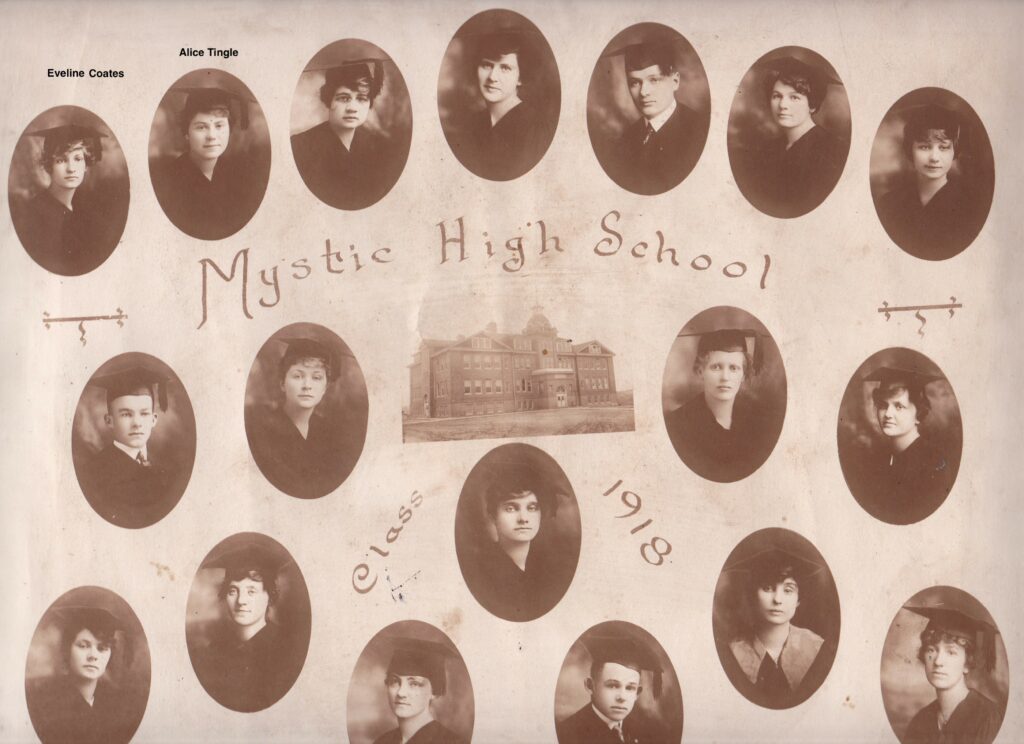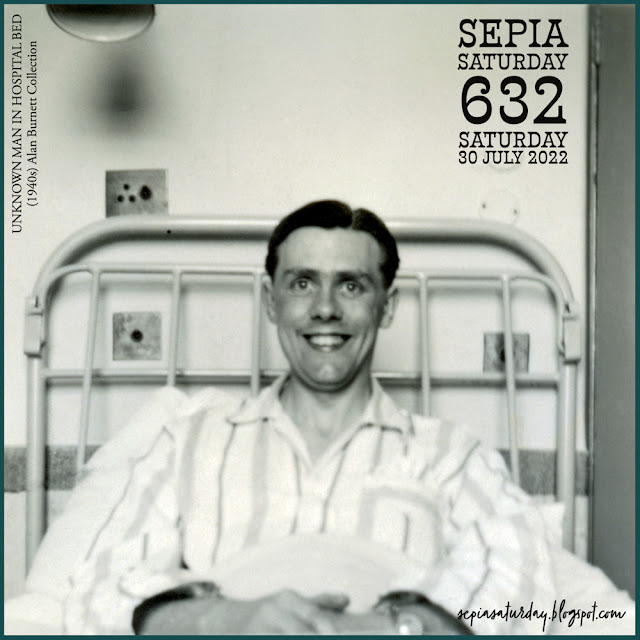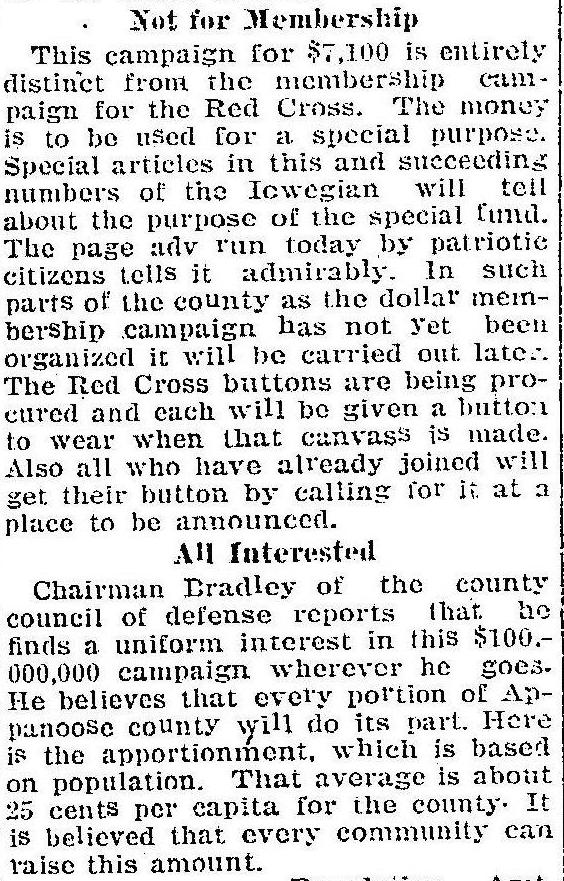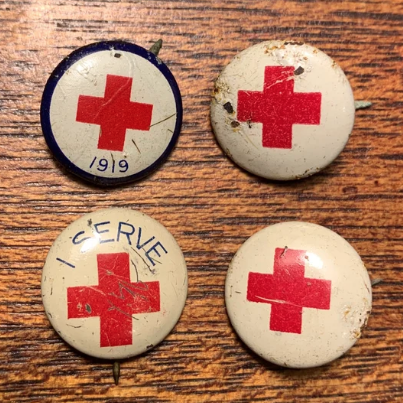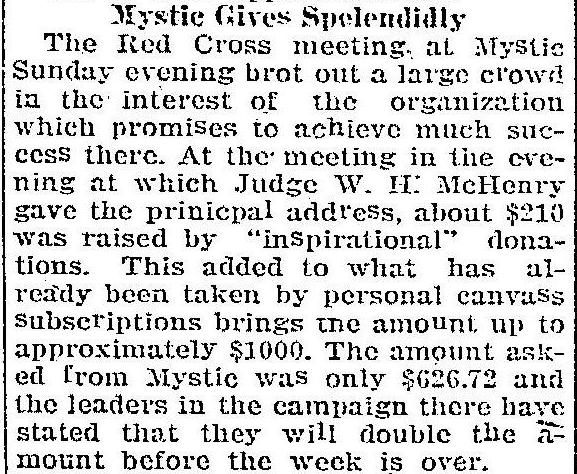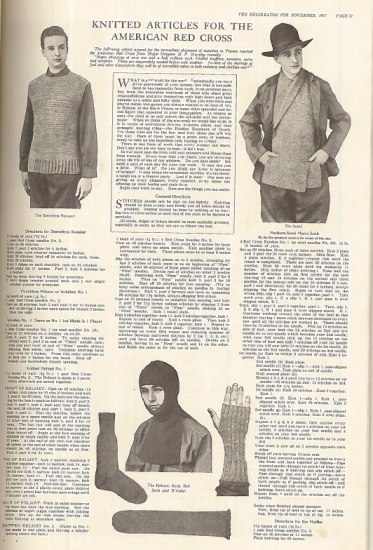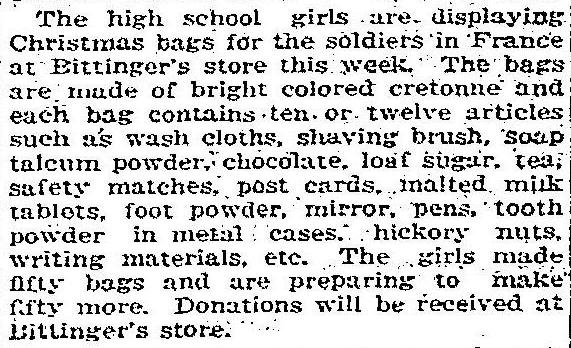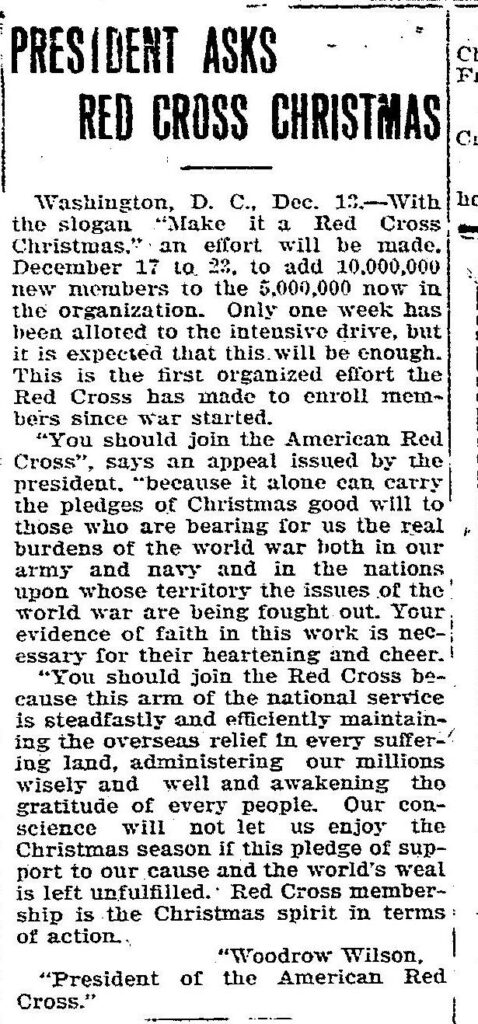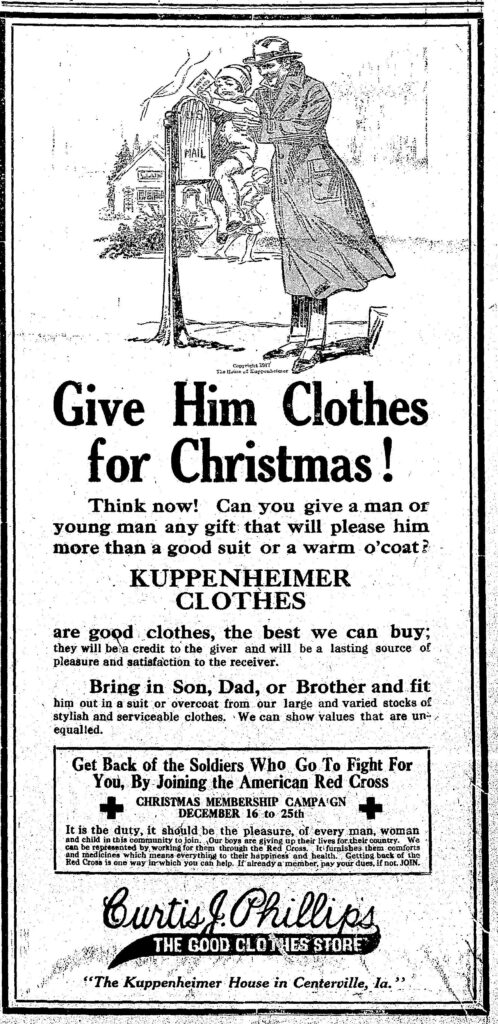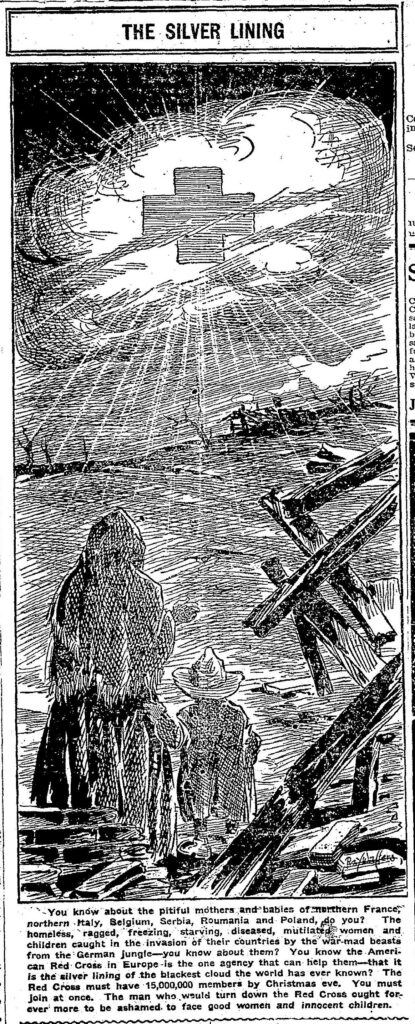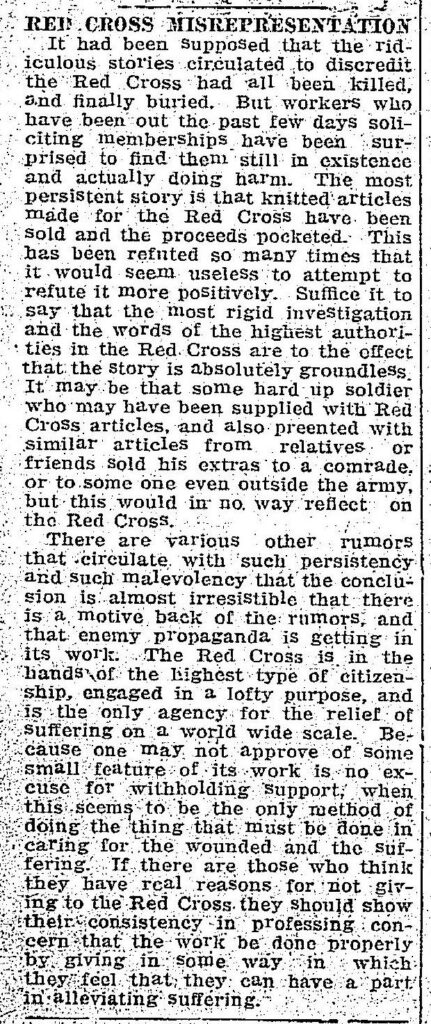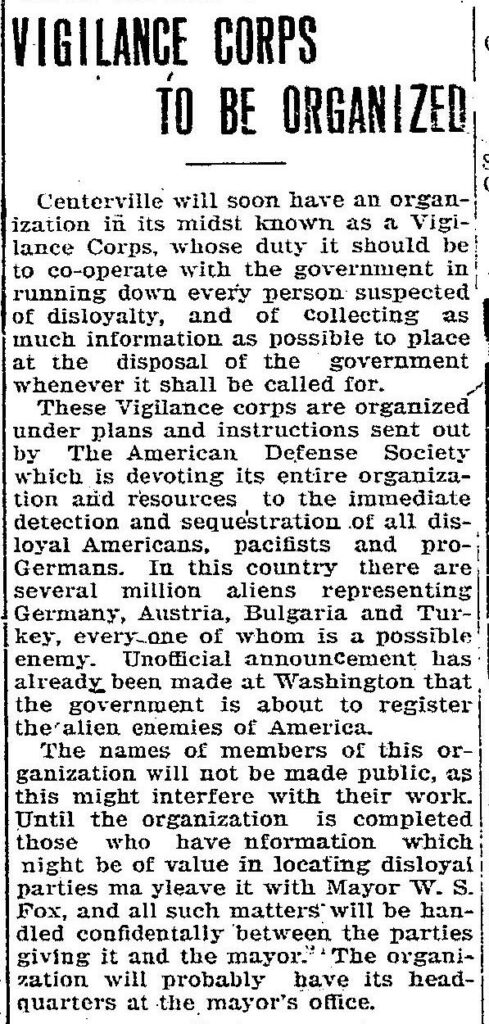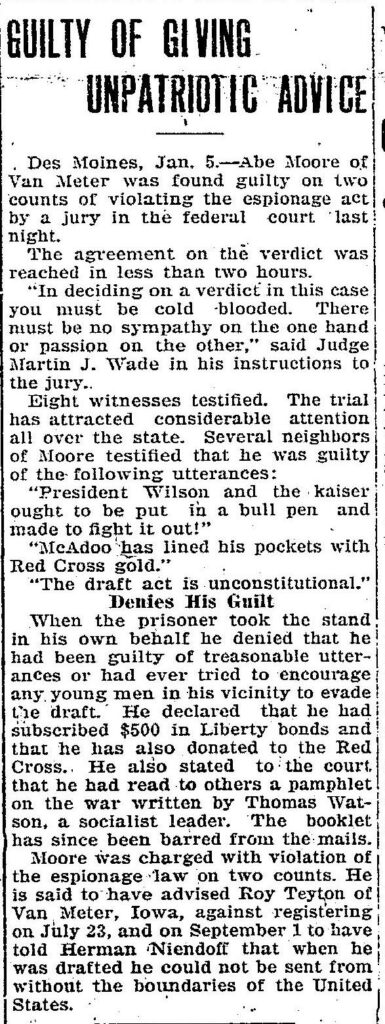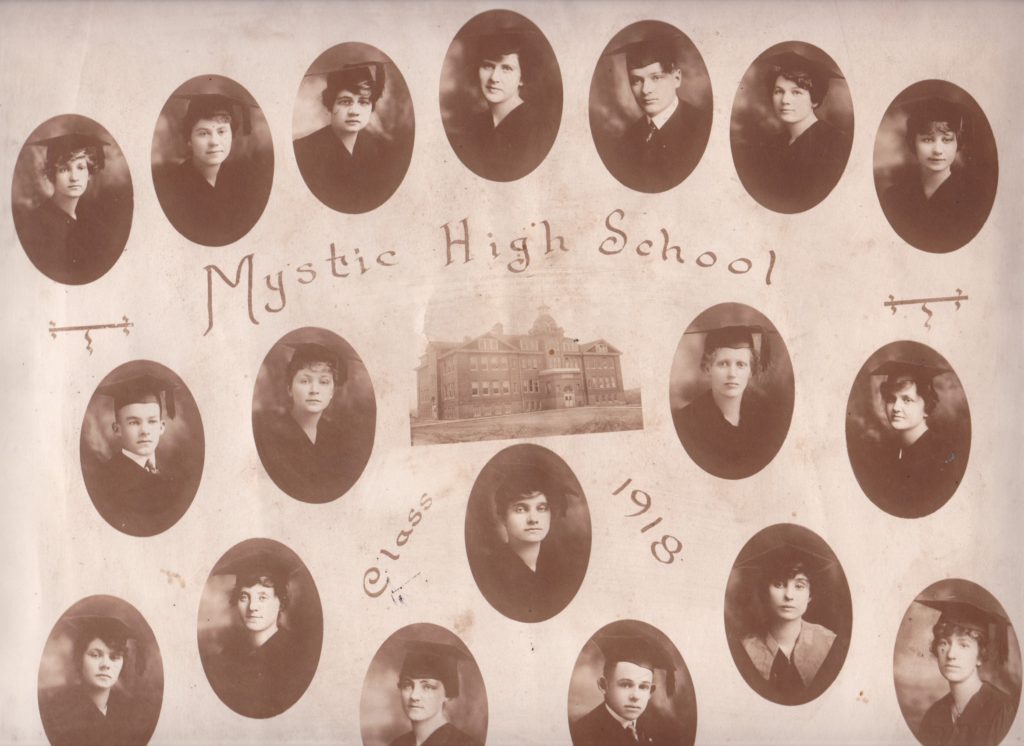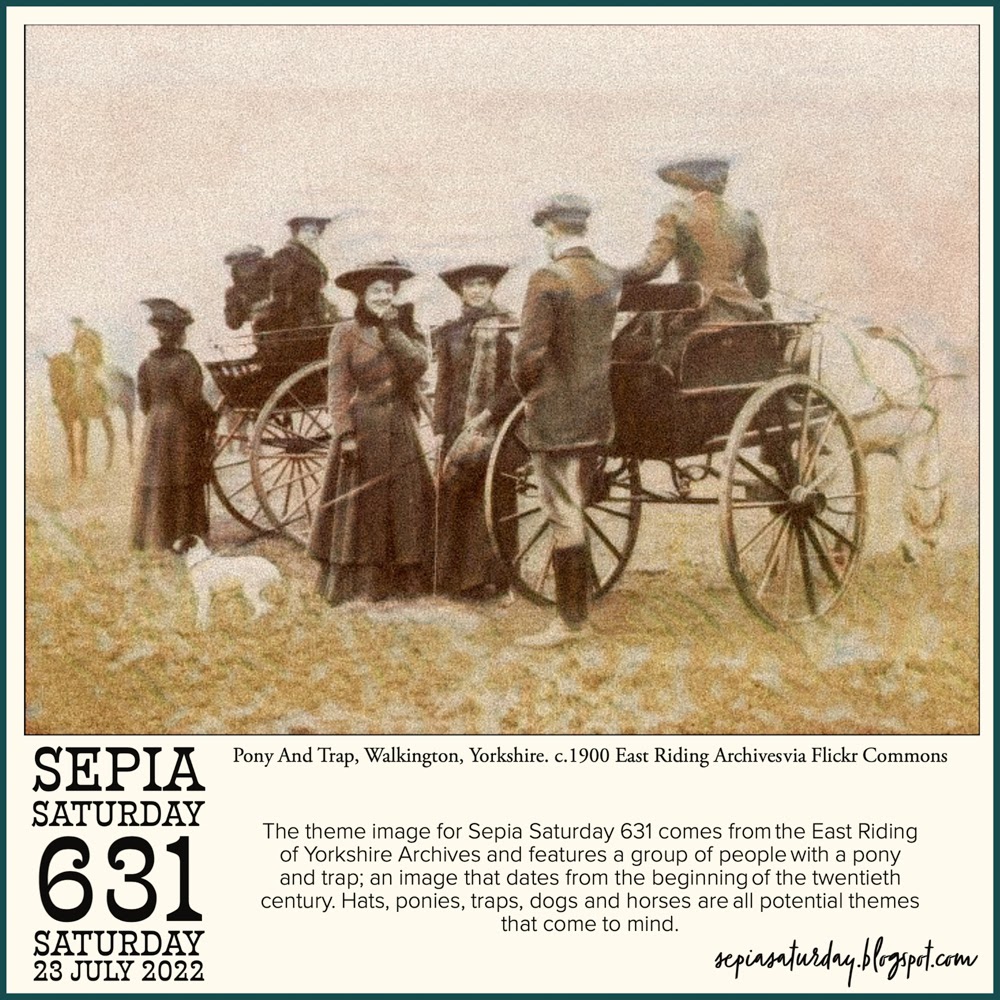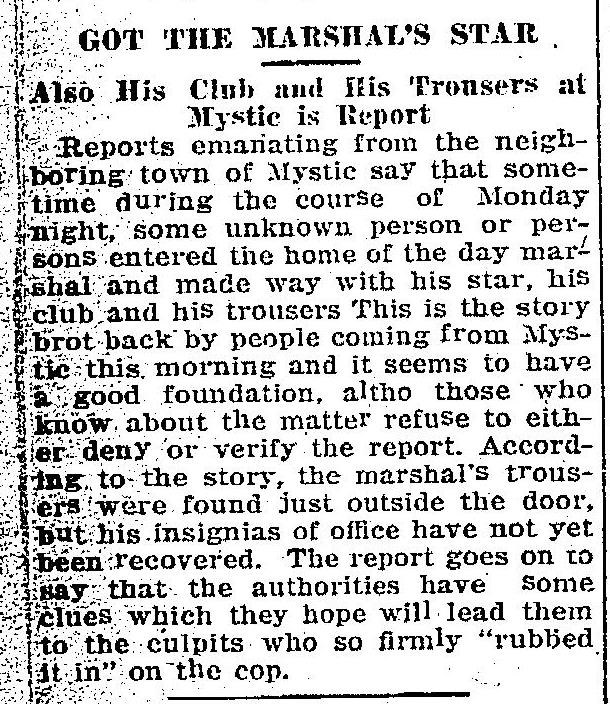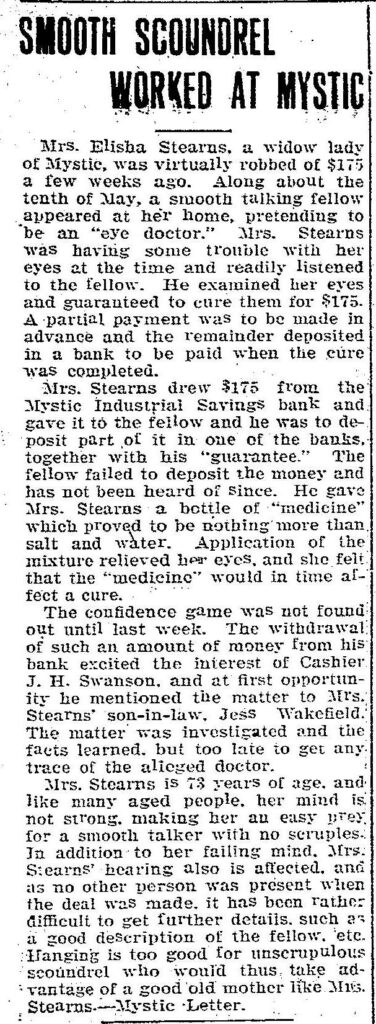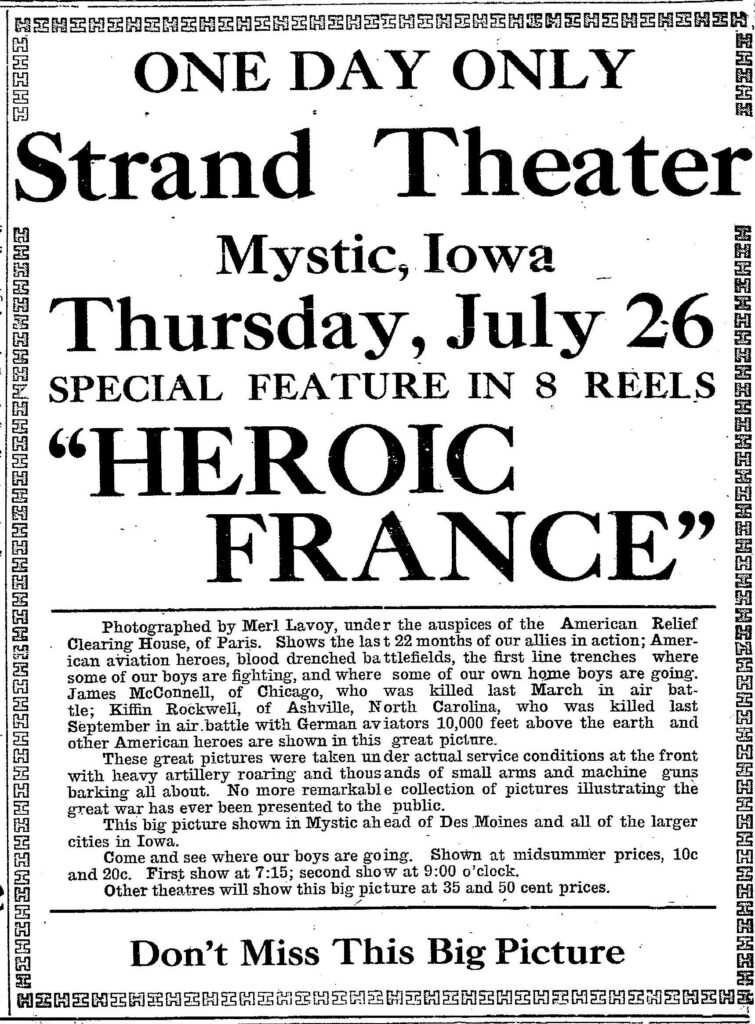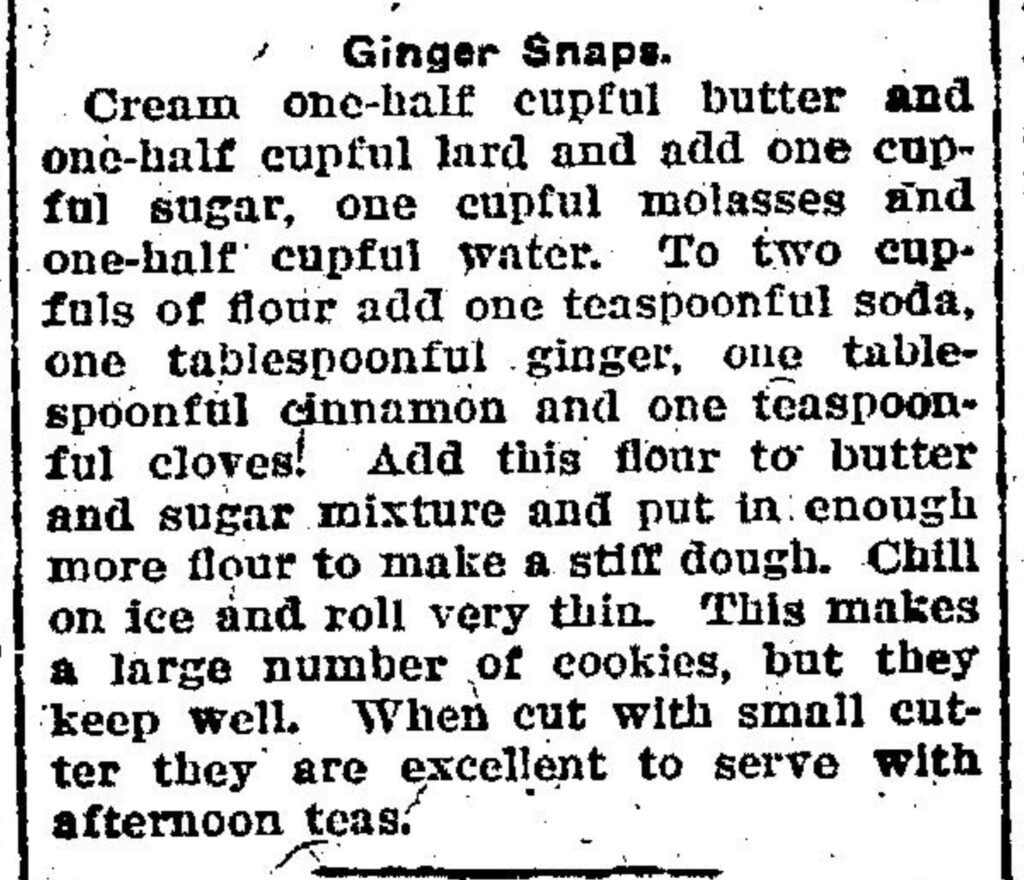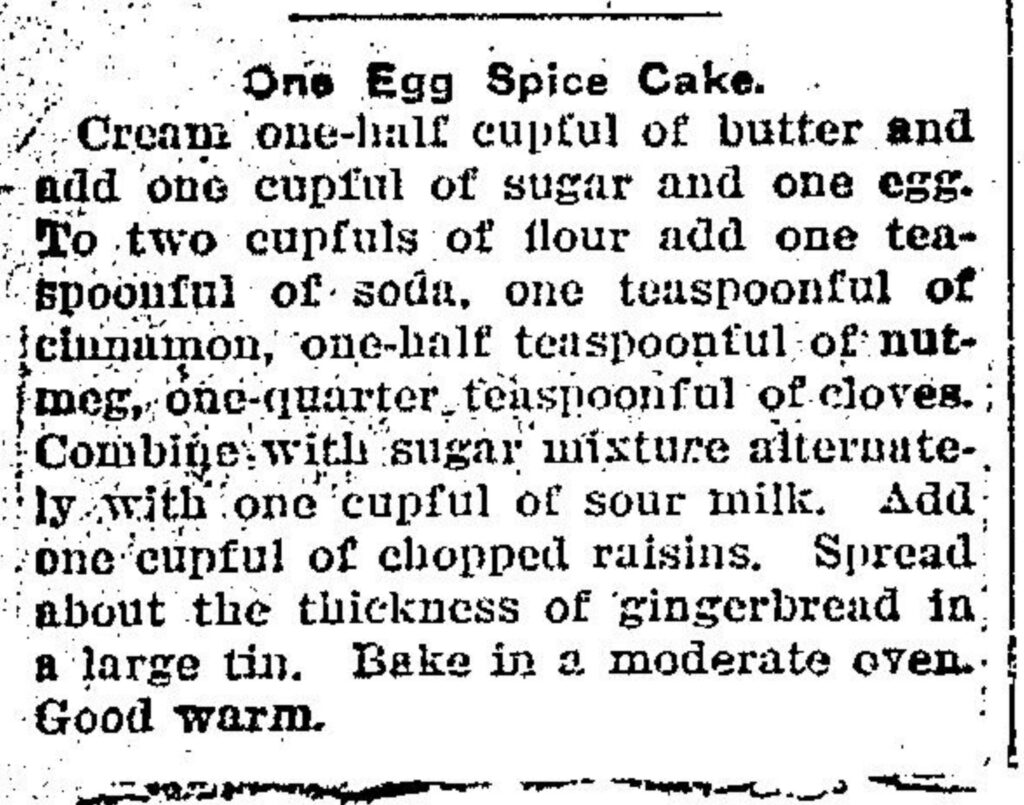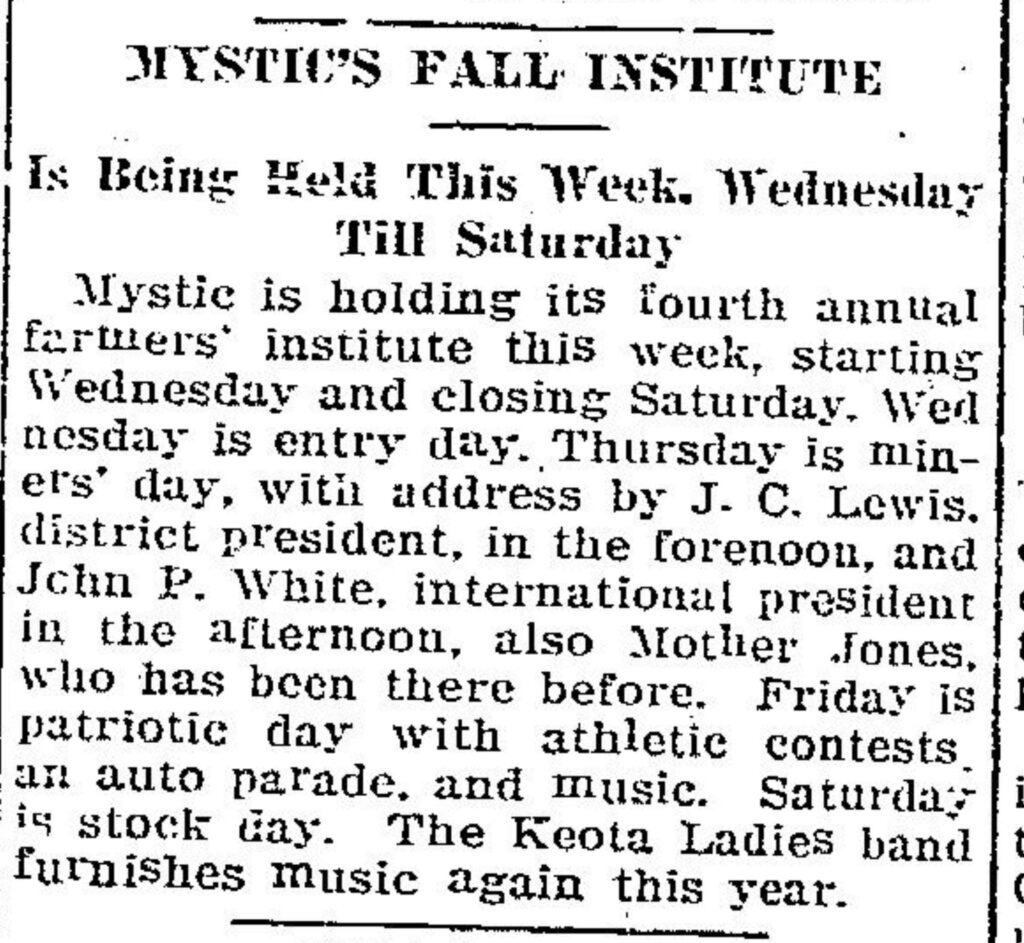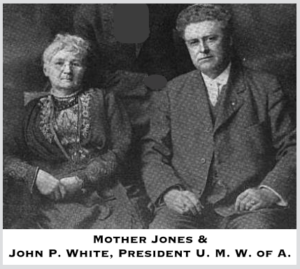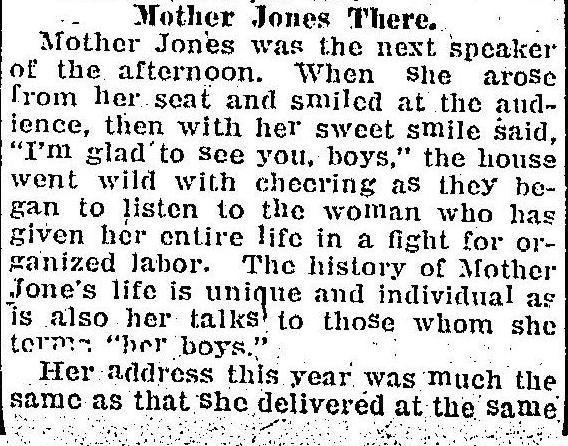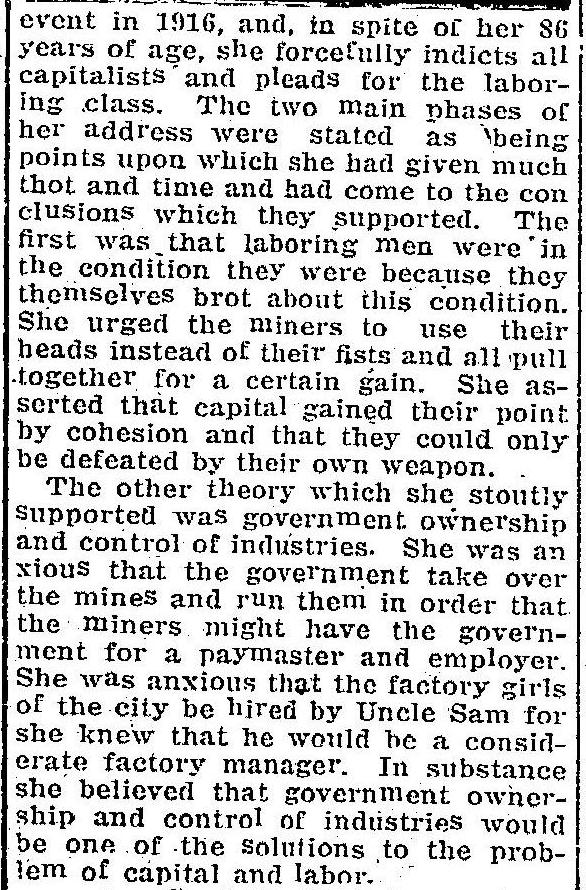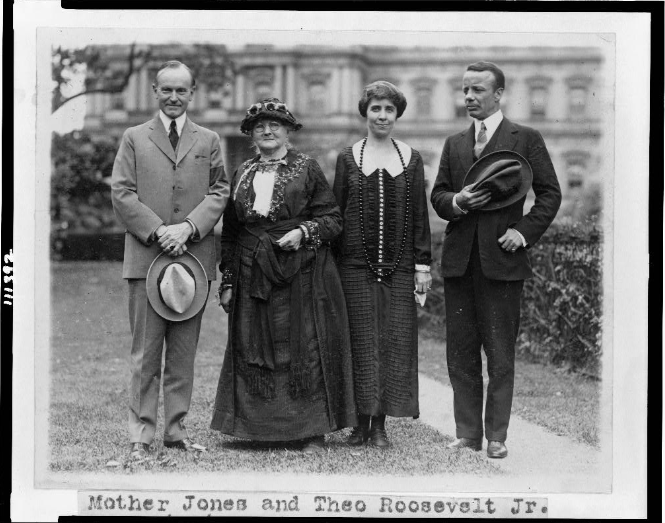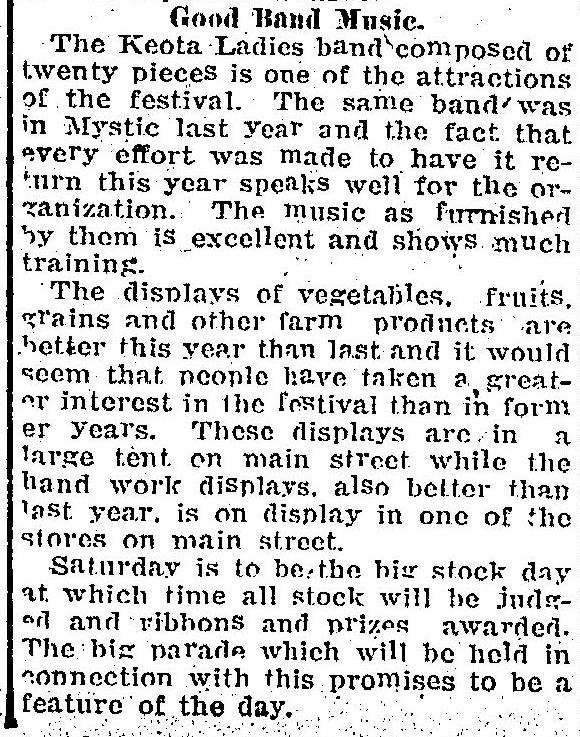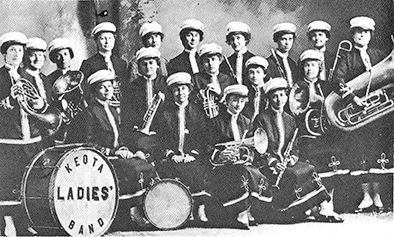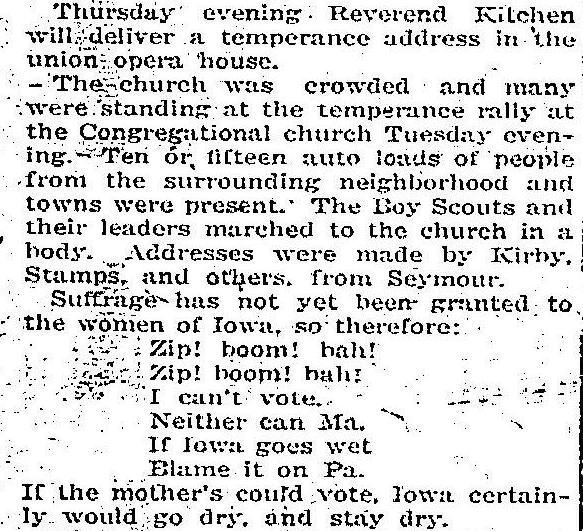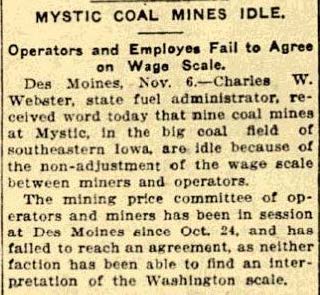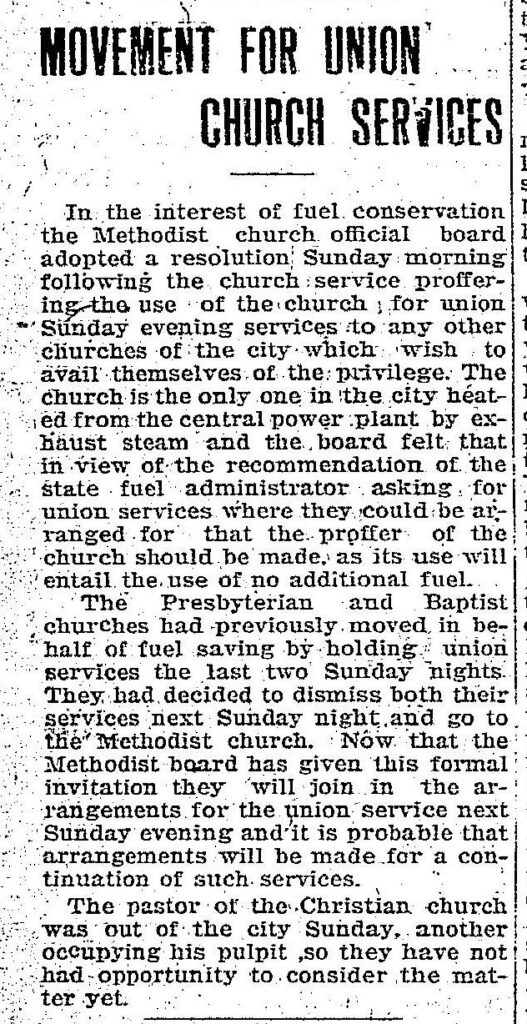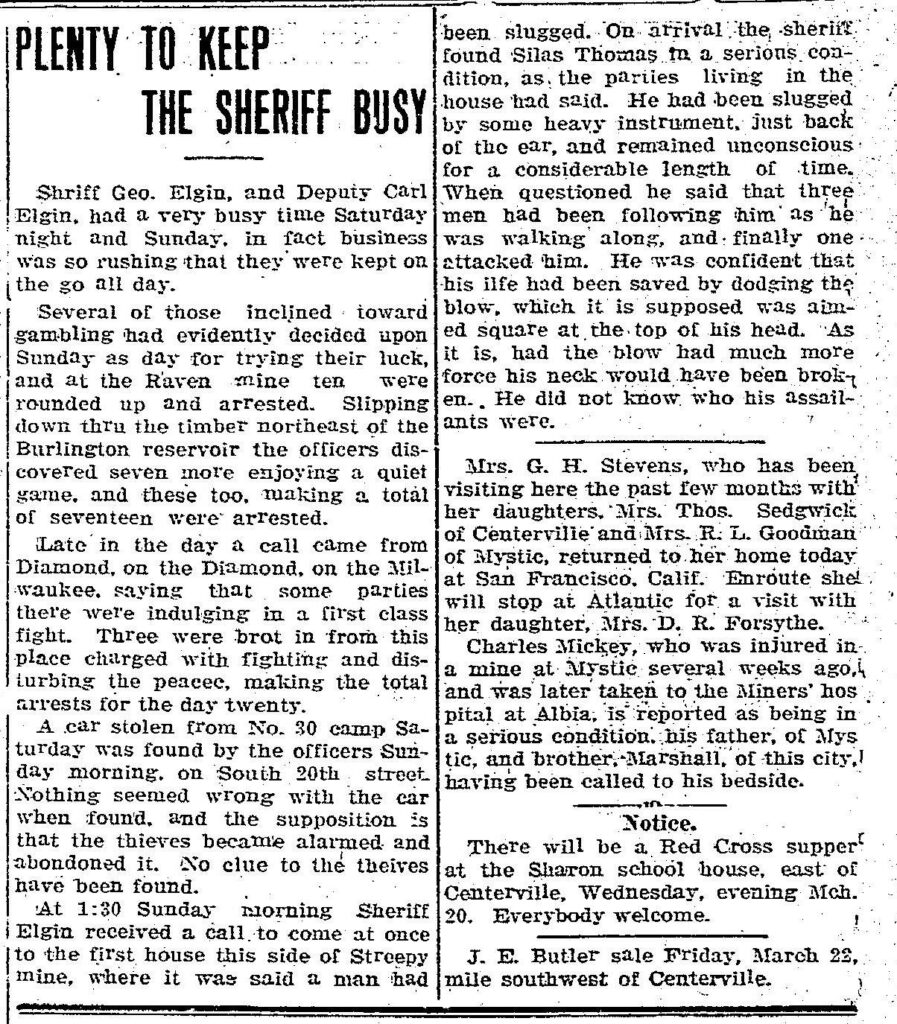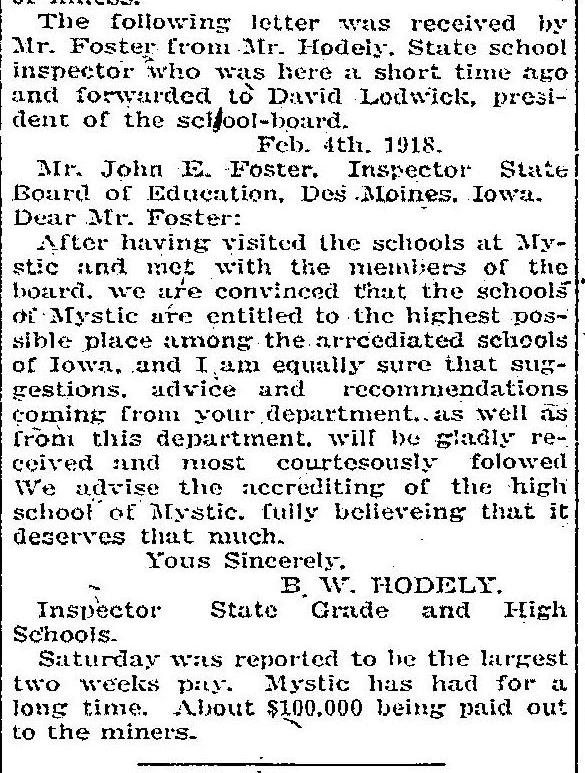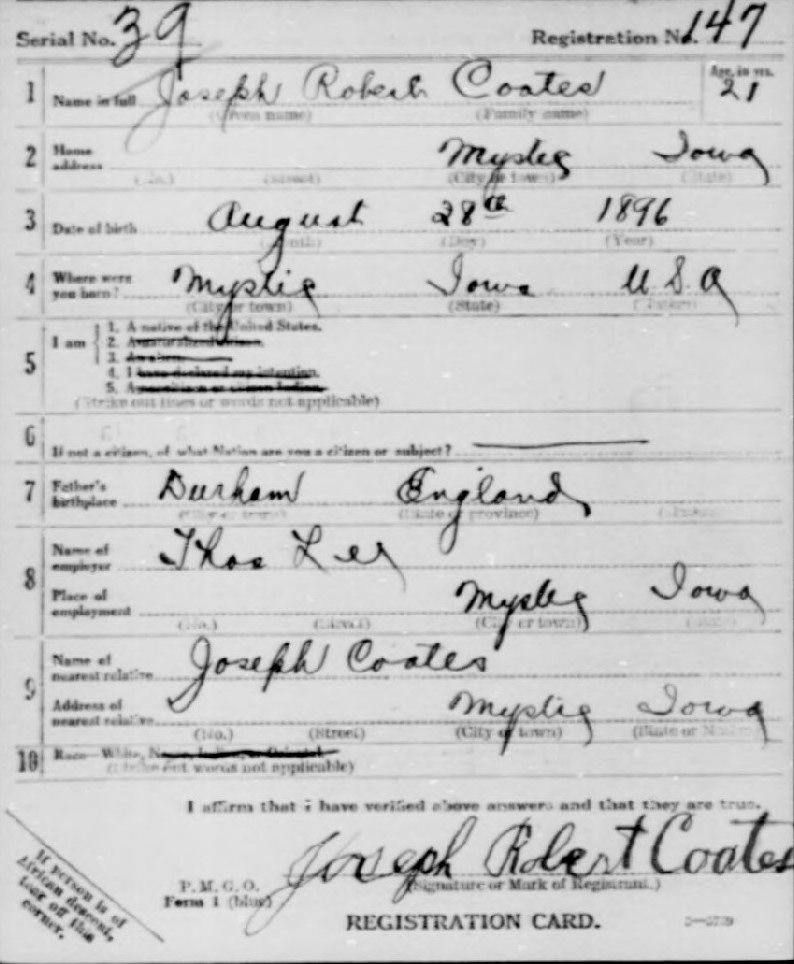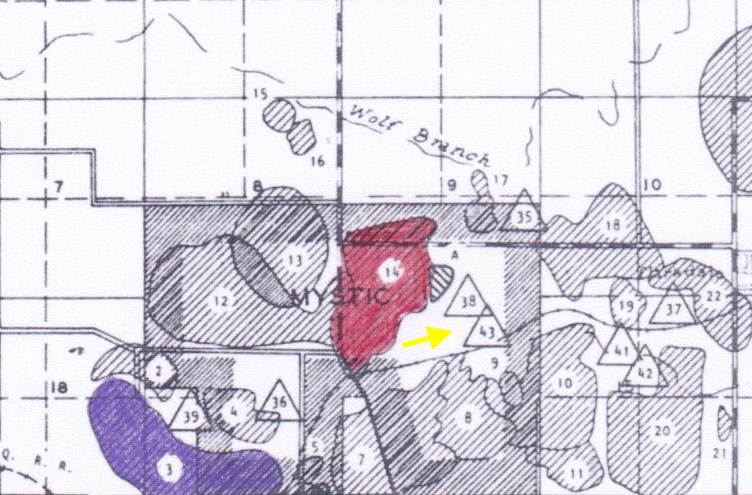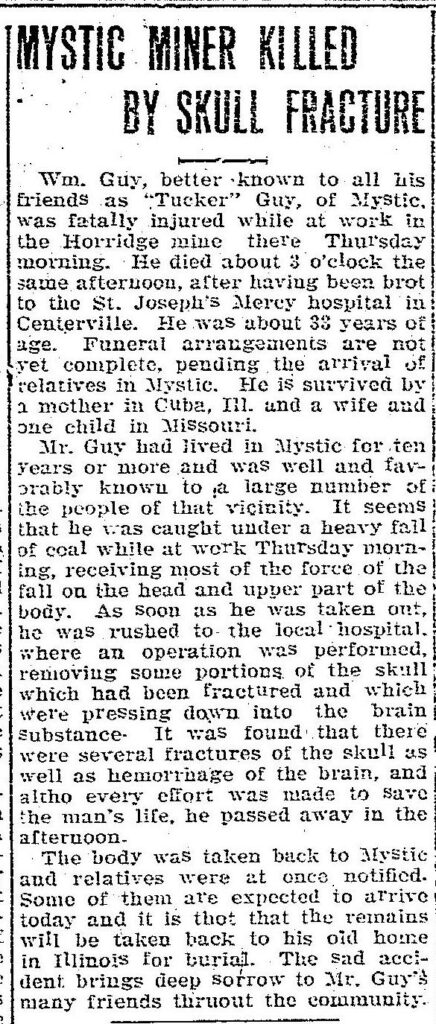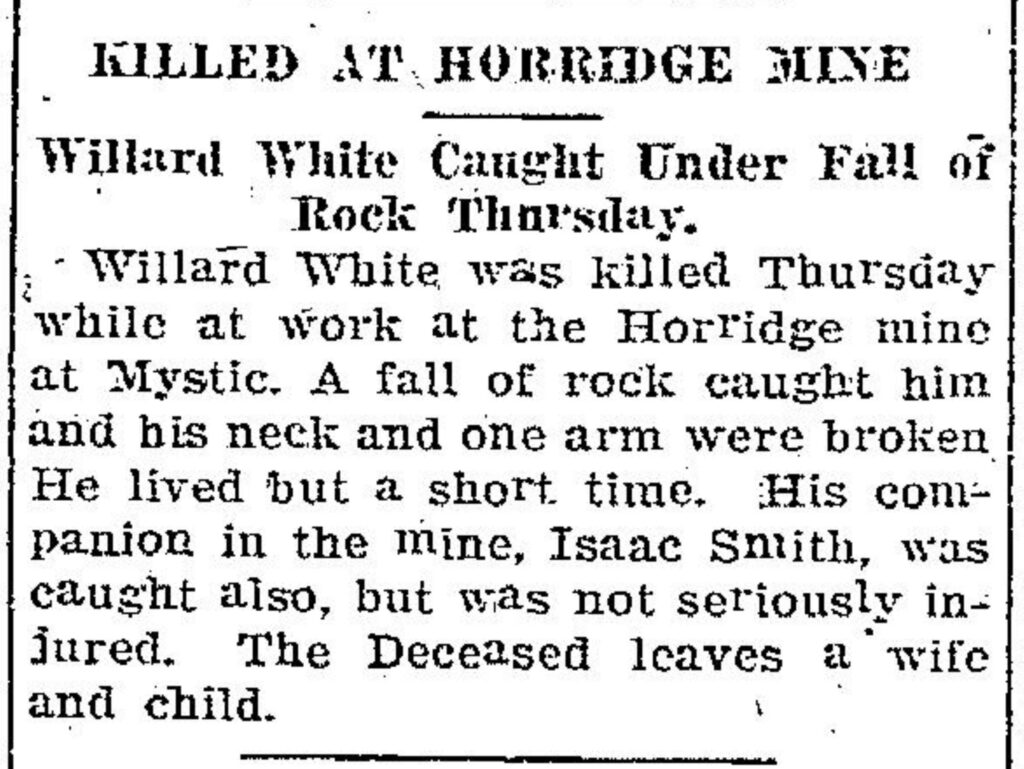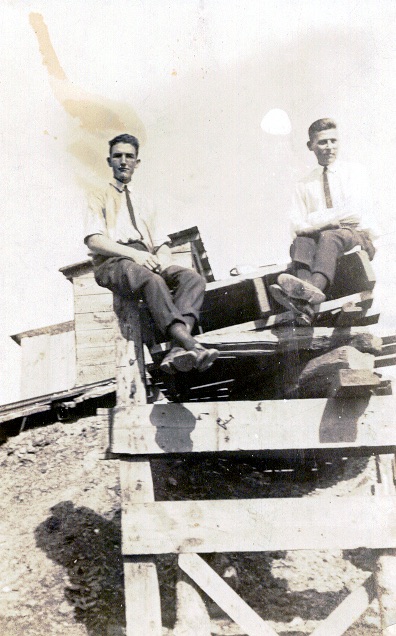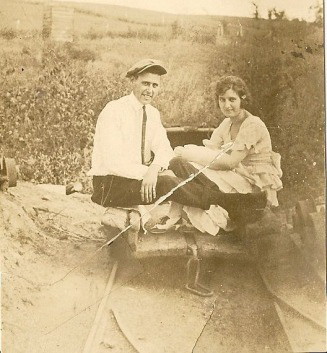I shared a photo of my grandmother Eveline Coates’ high school graduating class in Mystic, Iowa a few weeks (now months!) ago. Along with the photo and her diploma, a couple of other mementos were saved. One is the program for the Junior-Senior Banquet in honor of the graduating Seniors. It was interesting to see how World War I seemed to be the overarching theme of the festivities. I decided to take a deeper look at what her life may have been like during the 1917-1918 school year. There was a lot going on, a war and the beginning of an influenza pandemic to name the two biggies. The list of related posts is getting long, so I’ll link them at the bottom.
The prompt photo of a smiling man in a hospital bed seems the perfect time to mention the influence of the Red Cross during the time Eveline was a senior in high school. I keep trying to imagine why this young man has such a big smile. Maybe he was trying to impress a Red Cross nurse.
Once again, I have a bunch of newspaper clippings from Appanoose County saved. As I searched the internet for additional information, I came across a digitized book, The Red Cross in Iowa, which helps to put the newspaper articles I found in context. Since I’m not doing a research paper on the Red Cross in Iowa, I just skimmed for what looked relevant. My interest is simply to imagine my grandmother’s community and her life.
According to The Red Cross in Iowa, “No sooner had the United States declared that a state of war existed than persons in all parts of Iowa became inspired with a desire to have a Red Cross chapter established in their particular county, city, town, or village.” In Iowa, twenty-four Red Cross chapters were in operation the first of May. That number increased over two hundred per cent during the next two weeks. Iowa led all the states in the nation in the number of chapters formed during June 1917. At the end of the month, Iowa, with one hundred and twelve active chapters, had more than any other state, with New York second and Pennsylvania third. The national organization preferred that each county have one chapter headquartered in the county seat with jurisdiction over the entire county.
At the time of this big push to join the Red Cross, Eveline had just completed her Junior year of high school. I expected that the newspaper clippings I had saved would reflect this membership drive in June 1917. Instead, I found mostly news items about a national fund raising drive. Appanoose County was tasked with raising $7100 as their portion of the national campaign.
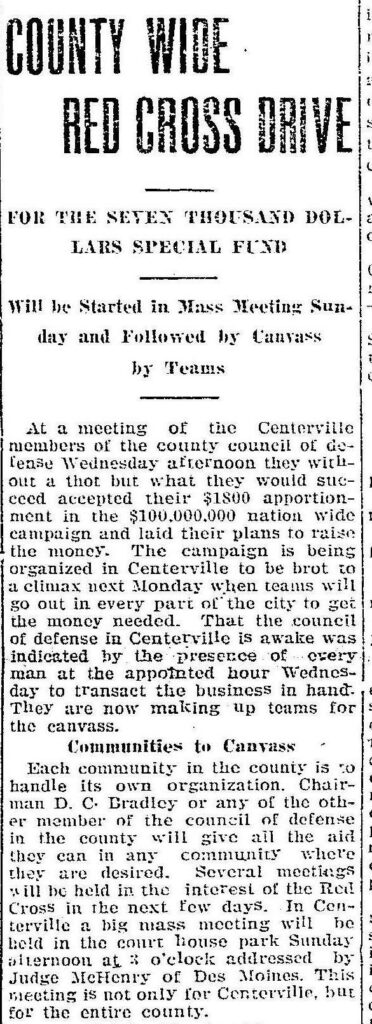
An individual membership was one dollar. Canvassers were identified by an “I Serve” Red Cross pin and gave a pin to each new member.
Mystic’s portion of the $7100 was $626.37.
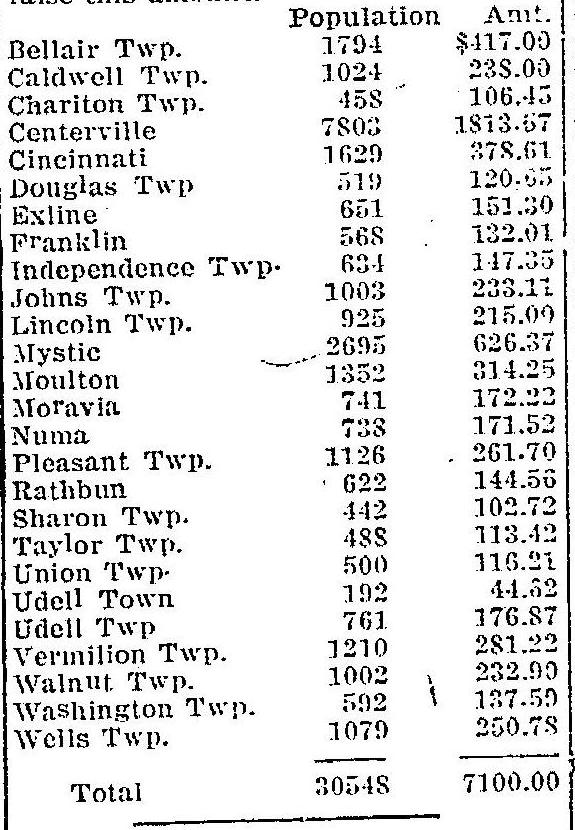
Shortly after the planning meeting in Centerville, Mystic announced that a patriotic Red Cross meeting would be held Sunday, June 25th. The committee also met with mine operators and foremen. When Eveline’s father and brothers went to work the following week, they were likely handed a pledge card and encouraged to donate.
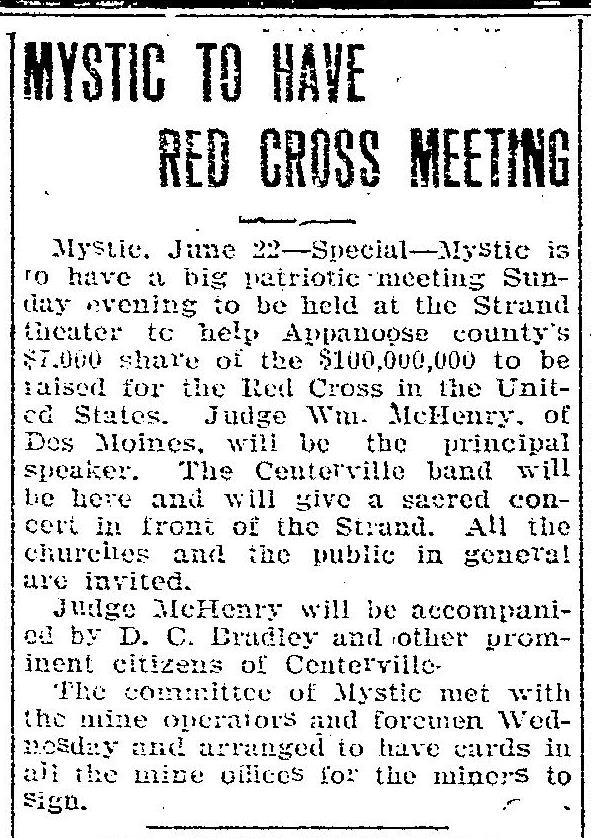
The program of the meeting is reported below.
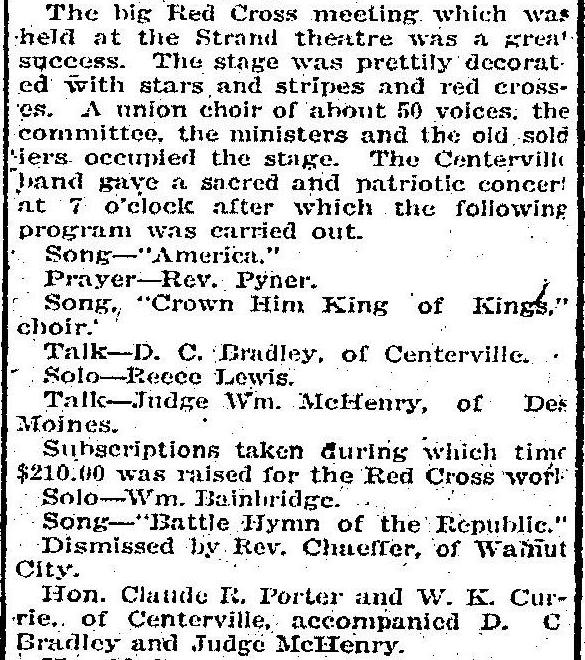
Most of the commenters in a Facebook group devoted to memories of Centerville and Appanoose County believe this photo was taken around 1930 inside the Strand Theater in Mystic. Rather than the many children and the tiger above the stage, imagine stars and stripes, red crosses, ministers, old soldiers, and a choir of 50 voices along with the speakers. One of the articles above places the Centerville Band playing outside the theater.
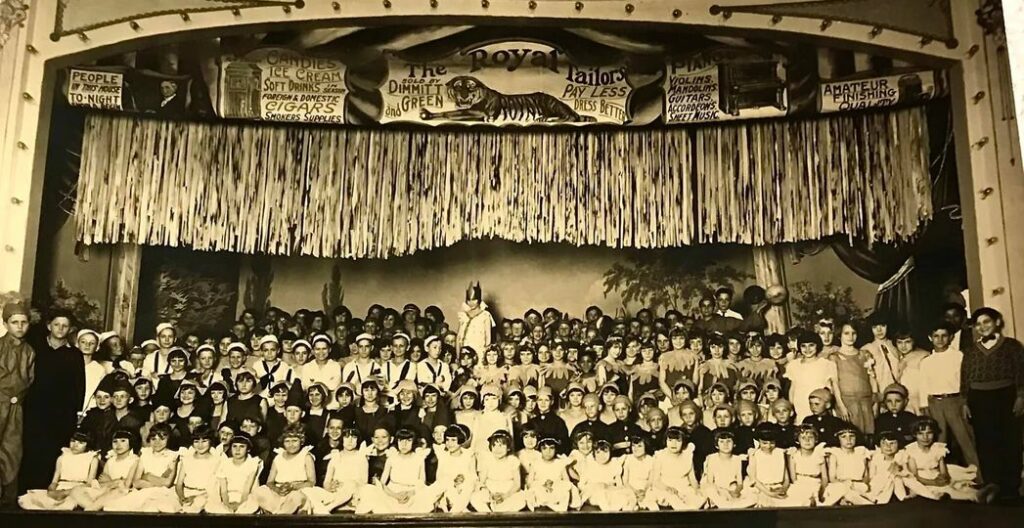
This photo of the Strand Theater was taken in the early 1970s, well past its prime, probably not long before it was torn down.
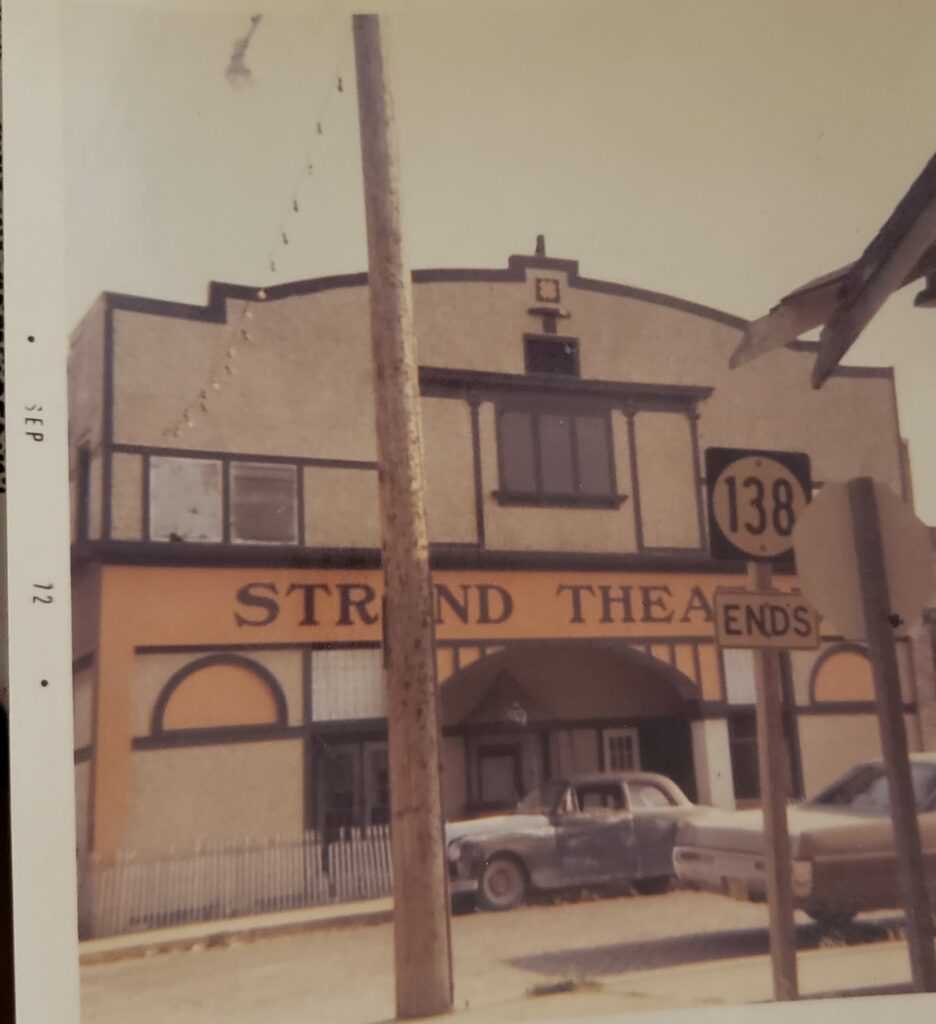
Mystic went above and beyond in giving to the Red Cross.
A follow-up article detailed the amounts raised by the coal companies in addition to personal subscriptions.
By early July, Mystic organized its own branch of the Red Cross, the third town in the county to do so. The county chairman is quoted as saying:
“The money for the work has been raised and the need now is that these societies keep up the interest and send to the national organization their contributions of bandages and other necessities.”
Centerville Daily Iowegian and Citizen, July 6, 1917
I have no way of knowing if Eveline’s family attended any of these events, joined the Red Cross, or participated in activities related to the Red Cross. I can say that they were certainly exposed to information and heartily encouraged to join. It would have been difficult to avoid.
The Mystic branch had a social affair in early August and the ladies of the society offered thanks and appreciation in the newspaper.
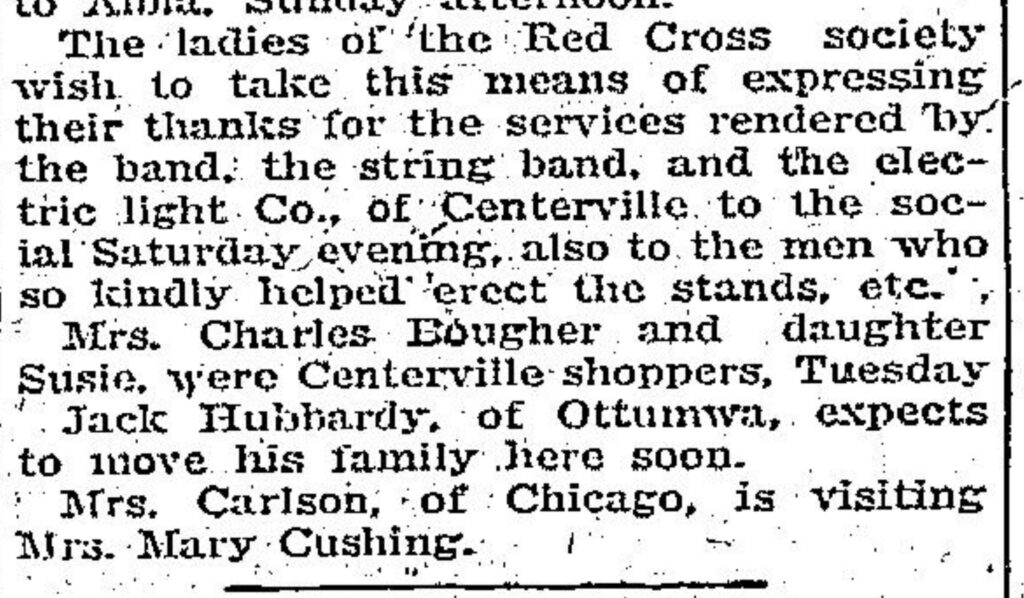
About twenty women gathered to make bandages in August. My understanding is that bandages were made by cutting large bolts of gauze into strips and lengths and rolling them.

Perhaps a work session looked a little like this one in Connecticut.
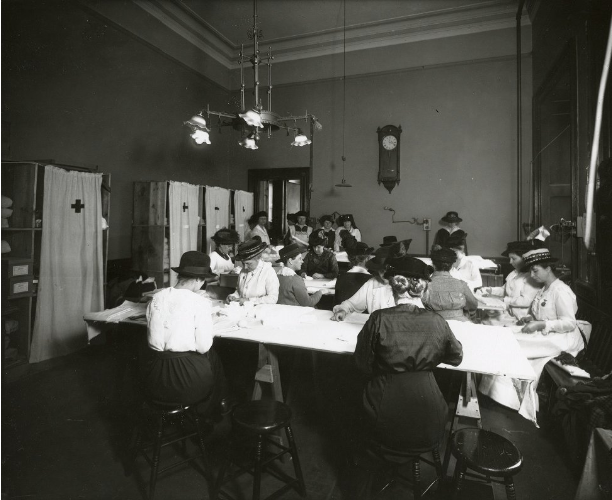
Around the time school started in the fall, the newspaper printed instructions for Red Cross knitting that included two kinds of wristlets, a muffler, and a sleeveless sweater. Below is a scan from one of the Red Cross booklets, showing completed items.
In addition to the instructions in the newspaper, one might have seen posters around town promoting knitting for the Red Cross.
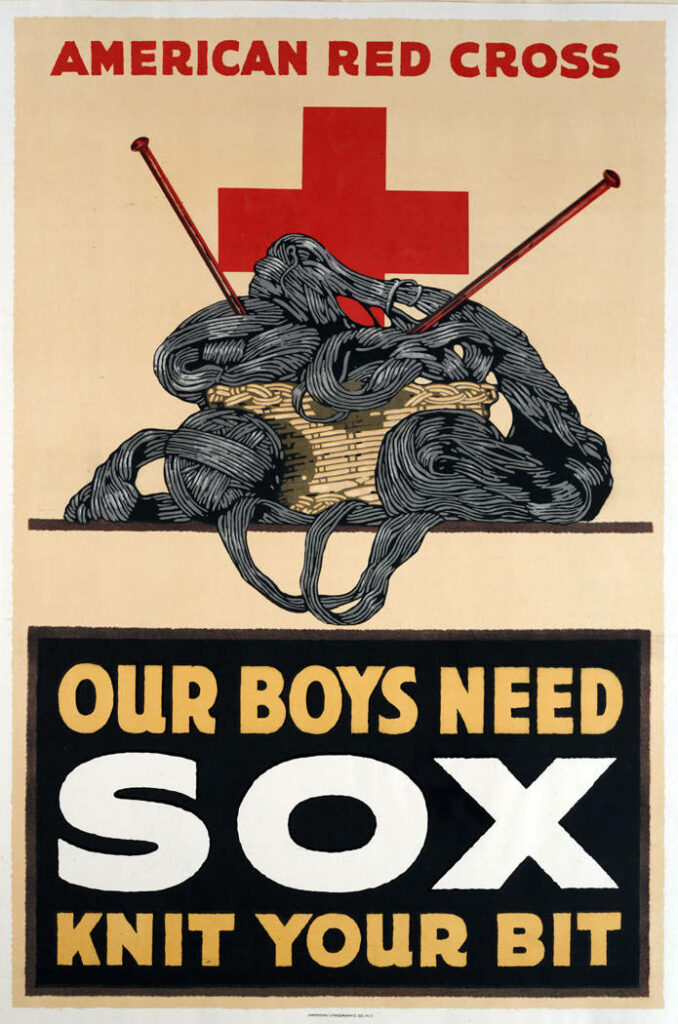
I didn’t find anything about a Junior Red Cross for school children in Mystic, but a group of unidentified high school girls prepared Christmas comfort kits for solders. The kits were displayed in a local store. I don’t know if Eveline participated, but she knew her brother would likely be called up soon and might have wanted to do her part to support the soldiers.
The next big membership drive was planned for the week before Christmas. President Woodrow Wilson, who was also President of the Red Cross, put out a proclamation announcing the Christmas membership drive.
The national committee of the Red Cross made extensive plans to bring the campaign to the general public. Posters, pamphlets, cards, and other forms of publicity were forwarded to the chapters. Many magazines with a national circulation agreed to give free advertising space to the Red Cross for the Christmas Campaign.
A publicity campaign was also outlined for the chapter publicity committees. Arrangements were to be made with local merchants for window displays showing articles produced by the Red Cross. Proofs of several advertisements were prepared by the national committee and were sent to the chapters, which were urged to have local advertisers donate their space on certain days. The mayor was to be asked to issue a proclamation on the opening day of the drive and to raise the Red Cross flag over the municipal building. Local speakers’ bureaus were asked to secure a record of all public meetings, benefits, and theatrical performances, and make arrangements to have them addressed by Red Cross speakers. The bureaus were also to arrange for a Red Cross sermon in every church on December 23rd.
The Centerville papers ran business advertisements during the designated week that promoted the Red Cross, as well as articles as mentioned above.
The national committee suggested a schedule of events, covering the days from December 17th until Christmas:
Monday, December 17 – Publication of Governor’s Proclamation arranged by Division Offices. Public statement by the Chapter Chairman and by the Commanding Officer of any arm or navy post within the district.
In addition to the articles and advertisements provided by the Red Cross, the papers also ran some more dramatic pieces like the one below to encourage/appeal to/shame? readers to join the Red Cross.
Tuesday, December 18 – Civil Employees’ Day. Proclamation by the mayor. Raising of Red Cross Flag on the principal municipal building – to be displayed throughout the campaign.
Wednesday, December 19 – Women’s Day, on which special tribute should be paid to the work which women are doing in the Red Cross. Meetings of local women’s organizations. Special exercise in workroom, etc. Peak of the House to House Canvass.
Thursday, December 20 – School Day, on which every teacher will speak on the significance of the Red Cross and upon the significance of the Christmas ceremony.
I imagine, then, that Eveline and her classmates heard their teachers speak about the Red Cross and the upcoming Christmas ceremony. It was not enough that each family had a member of the Red Cross, it was hoped that everyone in a household would join and participate in the activities of the Red Cross.
Friday, December 21 – Employees’ Day, on which special tribute should be paid to the support which the laboring man is giving to the Red Cross. Concentrate on certain large factories on this day with speeches, solicitations, etc.
Saturday, December 22 – Boy Scouts’ Day, on which Boy Scouts will be organized for canvass for membership.
Sunday, December 23 – Church Day, on which Christmas sermons on the Red Cross will be preached in every church.
Monday, December 24 – Red Cross Christmas Ceremony Day.
The Red Cross Christmas ceremony was planned to close out the Christmas Membership Campaign. During the campaign each member was to be given a Red Cross service flag to be placed in the window. On Christmas Eve at 7:30 a candle was to be placed behind each of these service flags so that expression might be given to “the universal aspect of the Red Cross.” In addition it was suggested that local committees arrange with the churches to chime their bells at 7:30 and at half-hour intervals until 9:00 o’clock, the time set for the end of the ceremony. It was also planned that in each community Red Cross workers should be organized into groups to walk each neighborhood singing Christmas carols.
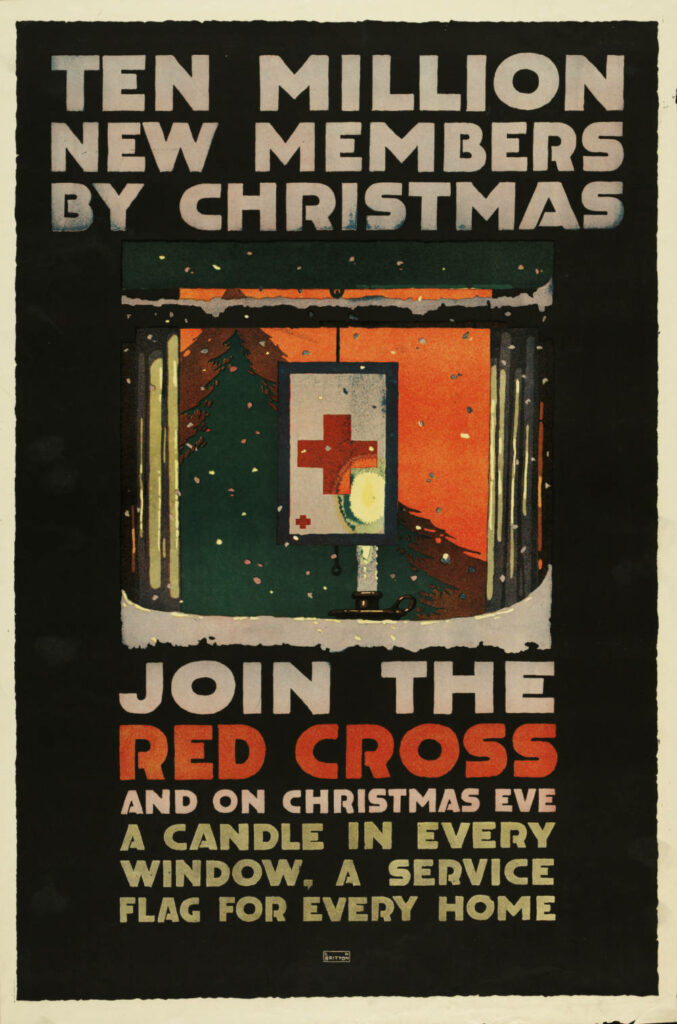
Due to the fire hazard involved in placing candles behind the Red Cross service flags, directions were later sent out from headquarters for chapters to discourage the use of candles. Oops!
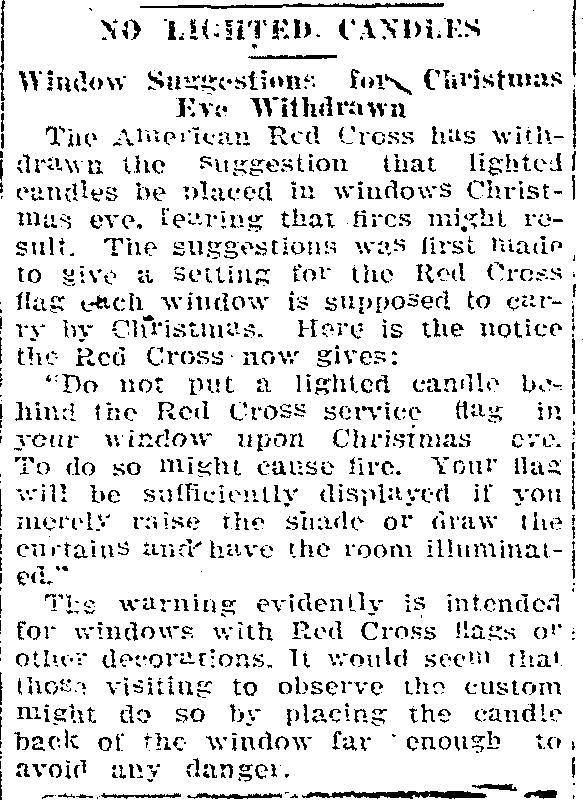
Besides the candle decision, there were some other hiccups along the way in the form of rumors that discouraged people from joining. Could it have been “enemy propaganda”?
I couldn’t verify that Mystic followed the calendar and other plans to the letter, but the amount of enthusiasm shown in the newspaper leads me to believe that Mystic and the entire county, followed the plan in spirit, if not in every detail.
Along with the articles promoting one’s patriotic and moral duty to join the Red Cross, I found some articles that might have spurred someone to join in order to protect their place in the community. During the week of the Christmas drive, a “Vigilance Corps” was formed in Centerville. One might hope to prove their loyalty by joining the Red Cross, contribute to the Y.M.C.A, or buy liberty bonds.
The mayor of Marshalltown (not in Appanoose County) lost his job because he wasn’t deemed patriotic enough.
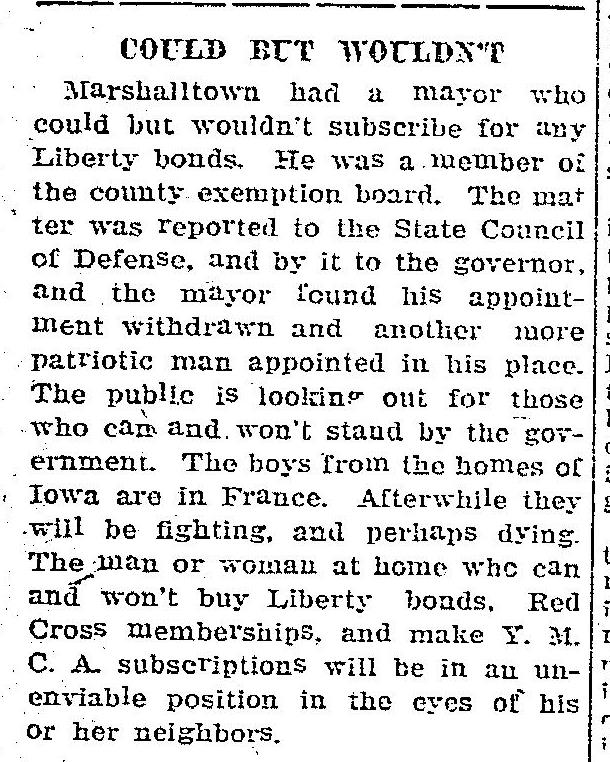
One town in Iowa chided residents for the low percentage of membership and praised a nearby German community for having 100% participation. Well … it seems pretty obvious that immigrants from particular countries, especially Germany, were eyed with suspicion, so of course they might have decided to band together and demonstrate their loyalty to the U. S. by joining the Red Cross. A couple of German immigrants in the state made the papers in January – one was found guilty of giving unpatriotic advice.
And another escaped lynching – twice.
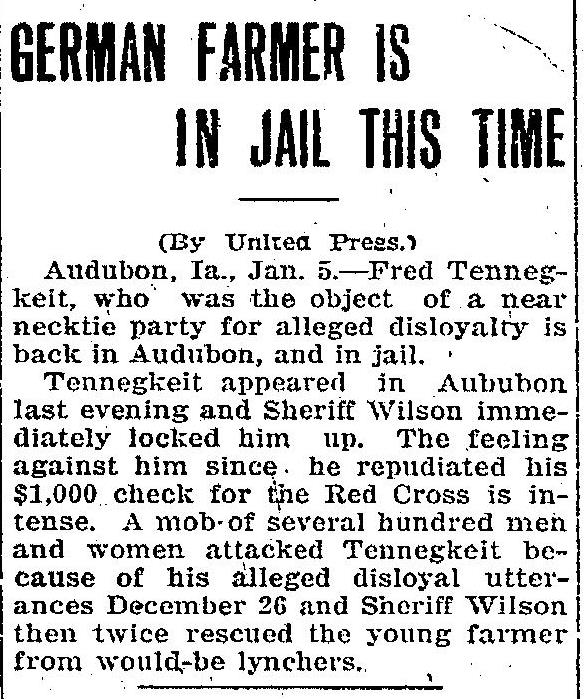
I don’t know where Eveline and her family stood in all of this, but I’m guessing that they joined the Red Cross. Whether out of a sense of supporting the charitable work or a feeling of duress, who knows? Maybe both. Surely anyone who did not join the Red Cross was subject to glaring side eyes at the very least.
Please visit other Sepia Saturday participants here: Sepia Saturday. You may have noticed that I used last week’s prompt photo. That’s because I didn’t finish last week’s post until today!
If you would like to read other posts about Eveline’s Senior Year, you can find them here:
Eveline’s Senior Year, Part 1
Eveline’s Senior Year: The Draft and a Carnival
Eveline’s Senior Year: A Look Around Town
Eveline’s Senior Year: Musical Notes
Eveline’s Senior Year: Smallpox
Eveline’s Senior Year: What are you Serving?
Eveline’s Senior Year: Root Beer on the 4th
Eveline’s Senior Year: Miners, Miner and Maps
Eveline’s Senior Year: The Weight of Mining
Eveline’s Senior Year: Gatherings and Gossip

